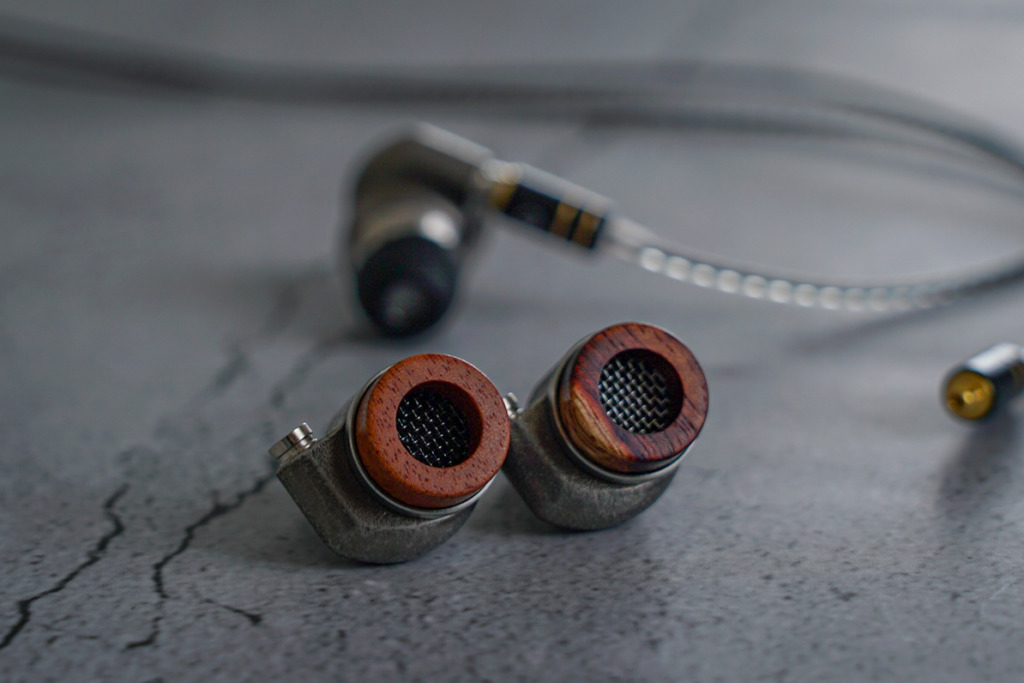LOAK2-TX02 is a model that is a renewal of LOAK-PROTOTYPE02. In this blog, I would like to provide details about LOAK2-TX02, compare its sound with other models, and explain the types of wood used for the rear enclosure. For ordering and basic information, please refer to the product page below.
Housing)
Front : Titanium.
Body : Titanium (3D printing).
Rear : Various types of wood.(Black stainless steel mesh)
The change from LOAK-PROTOTYPE to LOAK2-TX is the body housing. Both were 3D printed, but the manufacturer was changed to Japan, resulting in a higher performance and more sophisticated product. Problems that existed in the prototype enclosures, such as distortion and uneven stacking, have been improved.

Right : LOAK-TX

Right : LOAK-TX

The front housing of the LOAK2 is nearly identical in shape to the previous LOAK, but the internal structure is slightly different, incorporating thin stainless steel in the area where the drivers are secured. While titanium and aluminum are excellent materials for transmitting sound from the drivers to the nozzle tip due to their low vibration damping, they are not as effective at dampening the vibrations of dynamic drivers. Therefore, by incorporating stainless steel into the contact surface of the drivers, we are able to effectively suppress the vibrations of the dynamic drivers and achieve powerful bass and stable sound without distortion.
For the open portion of the backplate, we have slightly increased the inner diameter compared to previous OPEN types. This is to slightly reduce the rebound of air inside the rear housing, making the movement of the diaphragm softer and clearly distinguishing it from CLOSED types. Also, to distinguish it from the flagship model LOAK2-TX03, the mesh on the open part of this LOAK2-TX02 is black in color.

Left : TX02、Right : TX03

The characteristics of sound and comparison with other models)
LOAK2-TX02 delivers a sound profile very similar to the old LOAK-PROTOTYPE02, characterized by its bold and powerful warmth. It boasts a rich, warm tone with a tight, contemporary sound, offering a different direction compared to the crisp and tight modern sound. Additionally, the rich mid-bass of LOAK2-TX02 creates an ambiance akin to live performances, with abundant resonance and coloration.
The change in the manufacturing company of the 3D-printed housing for the LOAK-TX has resulted in a slight difference in hardness compared to the previous 3D-printed housing. The old PROTOTYPE housing had a stronger edge to the sound and a clearer graininess, while the TX housing has a smoother and more connected sound. This difference is subtle and may only become apparent upon direct comparison.

Comparison of sound with LOAK2-Ti(OP):
LOAK2-Ti(OP) is also a reimagined model based on the old LOAK-PROTOTYPE02, just like LOAK2-TX02, but the choice between 3D printing and CNC machining for the body casing results in different sound characteristics. In terms of sound profile, clarity, resolution, response speed, resonance, richness, and luster, LOAK-TX02 seems to excel. Particularly, in the bass department, TX02 offers more firmness and elasticity. The bass is well-defined and resonant, with ample richness.
In fact, there isn’t much significant difference in frequency measurements between these two models. However, in terms of aspects that make music feel more real, such as the beauty of sound resonance, its richness, and the spaciousness it offers, TX02 is clearly superior to Ti(OP).
Comparison of sound with LOAK2-TX01:
When comparing the flagship models, LOAK2-TX01 and LOAK2-TX02, TX02 delivers a thicker and more powerful sound. Particularly in the mid-bass to midrange frequencies, this is evident, as TX02 adds depth and atmosphere to the soundstage, whereas TX01 offers a clearer and more transparent presentation in the mid-bass to midrange frequencies. There’s also a difference in the warmth of the sound, with TX02 being warmer and softer compared to TX01.
If you prioritize a clear and defined sound with sharp contours, resolution, and emphasis on the high frequencies, TX01 might be your choice. On the other hand, if you value the richness of soundstage, presence similar to live performances, and emphasis on the mid to low frequencies, then TX02 would be preferred. For me, I use these two models interchangeably, not based on superiority but on personal preference and compatibility with the music I’m listening to.

Regarding the choice of backplate)
Since this model is of the open-back (OP) type, the difference in sound due to the choice of wood and metal for the rear enclosure is relatively small compared to the closed-back (CL) type. Regardless of the chosen material, there is no difference in the sound of LOAK2-TX02, and there is not a significant change that would make it sound like other models. However, upon careful listening, there are subtle differences discernible in the sound.
For those who prefer a tight and well-defined sound, I recommend using hard and dense woods. Ebony or even harder materials would be suitable for this purpose.
If you prefer a slightly mellower sound, it is advisable to choose woods that are not overly hard. Woods softer than rosewood would be preferable.
If you are seeking a lighter and gentler sound, woods with moderate density would be preferable.
I chose Honduras Mahogany. Mahogany is relatively soft and has a lower density among the woods handled by 634EARS. Due to this hardness and density, the sound contours have a slightly rounded, soft, and mild quality. This characteristic of Mahogany enhances the smoothness and cohesion of TX02’s sound signature. While it may sacrifice some clarity in the sound contours, TX02 isn’t primarily characterized by clarity and sharpness, so I chose a wood that aligns with the direction of TX02. If you prefer a clearer sound, opting for a harder wood would be advisable.








